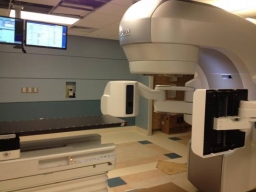Stereotactic RadioSurgery Fewer Treatments. Better Results for Cancer Patient.
Within a few years of the discovery of X-rays in 1896, cancer patients were being “treated” with radiation therapy. Multiple radiation treatments were often needed, usually combined with surgery. Side effects included hair loss and damage to tissues and organs near the cancer.
Radiotherapy Improves Its Aim
In the late 20 century, technology advancements led to better-focused beams of radiation. Treatments involved a radiation oncologist, a neurosurgeon and even a physicist to calculate the appropriate radiation dosage.
In the 21 century, cancer patients now have available “Stereotactic RadioSurgery” also know as SRS. Aside from the technical jargon, SRS basically uses computers and digital imaging to deliver large doses of radiation in small places with extreme accuracy. Three-dimensional digital imaging (CT, MRI or PET scan) is used to identify even the smallest tumors.
“Systems, called frames, can be used to immobilize a patient,providing us with a very stable and reproducible area to target,” says McLeod Chief Medical Physicist Tobin Hyman. “However, some newer technology allows SRS treatments to be undertaken without the frame, increasing patient comfort without compromising precision and accuracy.”
No Cutting in this Cutting-Edge Surgery
Although the term “surgery” is part of the procedure’s name, there is no physical incision. The ability to use an extremely focused radiation beam (or sometimes multiple beams) not only delivers a higher dose of radiation, but also results in fewer actual treatments and shorter sessions
SRS is most commonly used to treat tumors where the brain is the primary site or tumors that have spread from elsewhere (metastasized), such as the lung or abdomen. After treatment, cells shrink within a couple months. Using SRS, brain cancer patients were found to have improved survival over the older technique of radiating the whole brain OR using SRS in combination with whole-brain radiotherapy.
Stereotactic Body RadioTherapy (SBRT) uses technology that is similar to SRS for treating small-to-medium size tumors in the lung, liver, spine, abdomen and prostate.
“Using SRS we can target and treat a site only four millimeters (the size of a pencil eraser) from the brain stem,” says Neurosurgeon James Brennan of Florence Neurosurgery and Spine. Future involvement in the use of SRS at McLeod will include Dr. Brennan’s partners with Florence Neurosurgery and Spine: Dr. William Naso, Dr. Andrew Rhea, and Dr. Christopher Paramore.
Fewer Radiation Side Effects
Common side effects from regular external beam radiation treatments to the brain include hair loss, reddening of the skin and a general feeling of illness. Since SRS is more accurate and targeted, normal brain tissues are not hit with much radiation. Physical side effects are minimized. And the risk of memory loss — often experienced when wide areas of the brain are eradicated — are minimized with SRS.
Fractions and SRS
Radiation therapy plans include calculating what total dose of radiation will be required to successfully treat the tumor. Then the total is broken into small doses (fractions), because delivering all the radiation in a single dose might do more harm than good.
Using traditional radiation, a patient might need to be treated in 25 or more small doses or fractions.
SRS and SBRT’s ability to offer more focused doses that can track the minuscule movement of a tumor results in 2 patient benefits: 1) Higher doses of radiation can be delivered in a single treatment and 2) the number of treatments or fractions needed can be reduced to a mere handful for the disease sites where SRS or SBRT is indicated.
“Using traditional technology in the treatment of stereotactic cases, a brain tumor treatment may take 45 minutes or longer to image and treat a patient,” says Hyman. “With the SRS technology currently being installed and commissioned for clinical use at McLeod Regional Medical Center, similar cases will require less than 15 minutes to perform the same treatment.”
In addition to cancer, SRS can be used to treat benign conditions such Trigeminal Neuralgia, schwanomas, acoustic neuromas, and Arteriovenous Malformations (AVMs).
To find a physician, click here.
Sources include: McLeod Health, National Institutes of Health, Radiological Society of North America, American Society of Radiation Oncology, Cancer Research UK, Oncolink.org, Journal of Oncology (Cancernetowrk.com), Applied Radiation Oncology, R&D Magazine
-
McLEOD REGIONAL MEDICAL CENTER FLORENCE
843-777-2000 -
McLEOD DARLINGTON
843-777-1100 -
McLEOD DILLON
843-774-4111 -
McLEOD LORIS
843-716-7000 -
McLEOD SEACOAST
843-390-8100 -
McLEOD CHERAW
843-537-7881 -
McLEOD CLARENDON
803-433-3000



-
McLEOD REGIONAL MEDICAL CENTER FLORENCE
843-777-2000 -
McLEOD DARLINGTON
843-777-1100 -
McLEOD DILLON
843-774-4111 -
McLEOD LORIS
843-716-7000 -
McLEOD SEACOAST
843-390-8100 -
McLEOD CHERAW
843-537-7881 -
McLEOD CLARENDON
803-433-3000
 Find a Doctor
Find a Doctor  Locations
Locations  Services
Services 